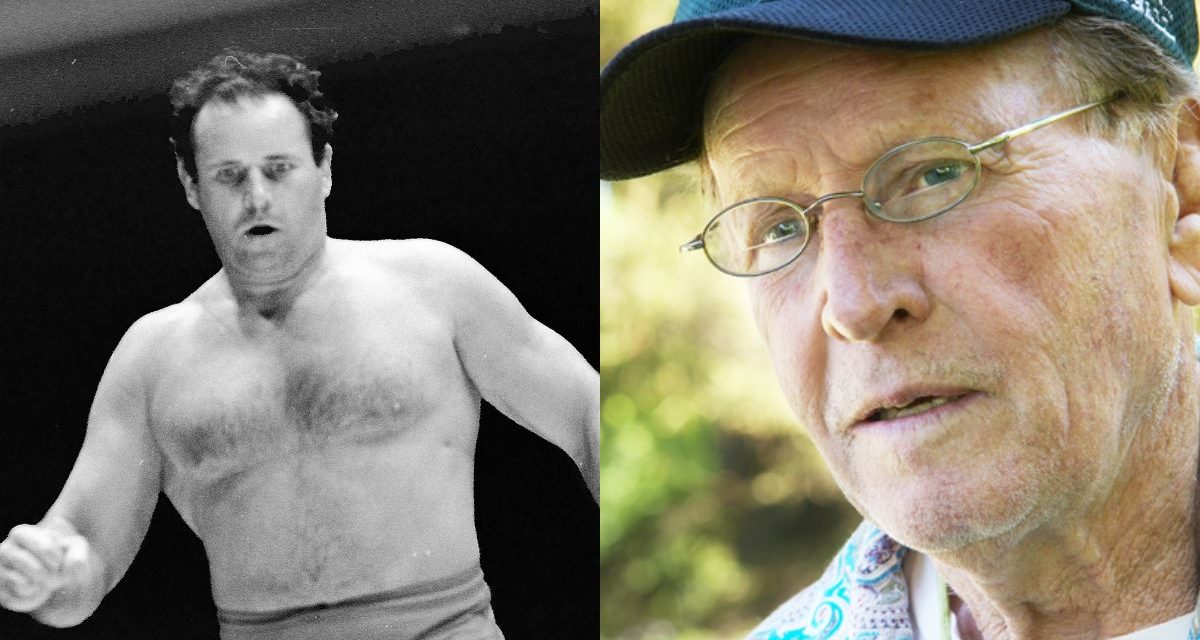Usually stories end with a coffin, but this one begins with one. There is no telling the tale of “Handsome” Johnny Barend without addressing his fascinating, far-out interviews in Hawaii, done initially from a closed, upright-standing coffin, cigar smoke rising from within, until opened, Barend rising to begin his promo.
Like some of the great comedy duos in history, Barend’s schtick could only work with a good straight man. That was the role for Ed Francis, who was the host of the 50th State Wrestling program in the 1960s and early ’70s, as well as the owner/promoter, or occasionally, Lord James Blears.
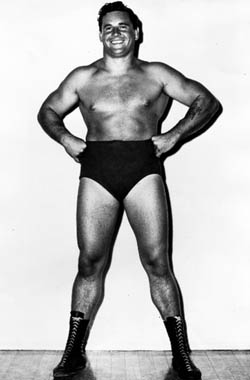
“Handsome” Johnny Barend. Photo courtesy of the Wrestling Revue Archives
“We’re going to go talk to Handsome John, and see what he has to say,” Francis would say, tentatively making his way through the darkened studio to approach the coffin, smoke rising from the cross cut in the top panel. Francis would knock, and the door would open slowly.
Cue Barend’s maniacal laughter. “Good evening, Mr. Francis,” he would intone, before launching into some fairy tale about chasing bugs in the woods. It was always entertaining, even if it wasn’t always about his upcoming bout.
“He did a coo-coo bit,” explained Nick Bockwinkel of Barend, who spent much time wrestling in Hawaii. “Ed Francis was always looking at the camera, kind of out of the corner of his eye — ‘Are you getting this? This is as much to me as it is to you.’ At that time, there were four channels in Honolulu, and 50% of the viewership was on this one channel at 4:30 in the afternoon until 6 p.m. It was just unreal, it was great, it was just too much.”
To Beauregarde (Larry Pitchford), who adapted a lot of his own act from Barend, the self-proclaimed Eighth Wonder of the World was no less than “the best interview that they had over there in Hawaii.”
“He had the charisma,” Beauregarde said. “He had a good build. He trained at the gym. He wasn’t like Hulk Hogan, but he was built.”
For future booker and owner “Cowboy” Bill Watts, Hawaii was an eye-opener. “They had the greatest interviews in the world. Johnny Barend, they had King Curtis Iaukea, Ripper Collins, they had all these guys,” he said. “And Ed Francis was the greatest straight man I have ever seen. He had Tally Ho Blears, but I’ll never forget those interviews with Johnny Barend.”
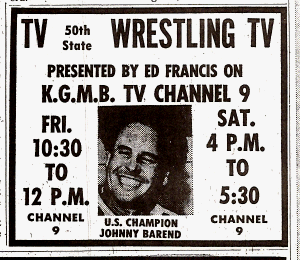
A clipping from Hawaii
The irony, of course, is that in conversation, Barend is rather vanilla. Comfortably retired from a second career in upstate New York running a small collection of rental cottages, he’s content to hang out with his wife of 37 years, Annie, their dog, Joy, their peacock, Lucky, and a noisy crew of chickens.
The colorful wrestling past is just that, the past. He did it, he lived it, he survived it, but to ask him about it, he’s not exactly sure why he did it for so long.
Born March 27, 1929 in Rochester, NY, Johnny Barend (sometimes spelled Behrend) started amateur wrestling when he was eight years old. After graduating Jefferson High in Rochester in 1944, it was time to serve his country, where he wrestled in the Navy.
“It just came kind of natural,” Barend said. “I had wrestled and beat everybody in the 19th Fleet, so this commander saw me at the time and put me in charge of this gym. They wanted me to go to the Olympics for the Navy, but I took my discharge instead. So later on, I got into wrestling and turned pro.”
Buffalo promoter Ed Don George was Barend’s professional teacher, and the babyfaced good guy would debut in western New York.
“Apple-cheeked Johnny Barend, the kid wrestler from Rochester, won the audience and his bout from Faro Rinaldi,” reads a Troy Record article from November 1949. In its November 1953 issue, Boxing & Wrestling declared Barend “the hottest thing to hit the bobby-sox brigade since Sinatra came down the pike, singing off key and through his adenoids.”
Barend’s first significant run as a good guy came in the mid-’50s in California, where he was paired with Enrique Torres as a tag team. “Fine gentleman, real nice man,” Barend recalled of Torres. “As a performer, he was great.” A Referee program from San Francisco, dated March 26, 1955, addresses the team: “Barend, who tips the scales at a neat 230 pounds, stands 6’1″ … He’s grappled many of the best around here as well as topnotchers in other sectors of the country … Barend has plenty of color and provides lots of action … Has grappling in team matches with Enrique Torres and they have done quite well.”
It wasn’t long after California that he made his first trip to Hawaii, for promoter Al Karasick. It would be a second home to him over the next few decades, and it was where he met his wife.
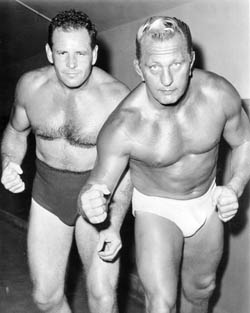
Johnny Barend and Buddy Rogers. Photo courtesy of the Wrestling Revue Archives
But back on the mainland, a friendship with “Nature Boy” Buddy Rogers developed, and Barend was often used as one of Rogers’ handpicked opponents — he was someone Rogers could trust in a business where few were deemed such. He is reluctant to say Rogers used his pull to only wrestle those on his side, but to the historians who covered Rogers’ career, there is little doubting it. Names like Billy Darnell, Reginald Siki and Bearcat Wright show up again and again in the record books.
“Yeah, there were a bunch of guys that he preferred to wrestle, I guess, if you put it that way,” Barend admitted.
Barend is still very protective of Rogers, stressing that he was one of the top performers in history, which made him a target for a lot of hatred — from the fans — and jealousy — from his fellow grapplers.
“They all hated Buddy Rogers to start with because a lot of these wrestlers were jealous of the guy because he was able to manipulate himself, and the guy was a good businessman. Instead of thinking of putting yourself in a better position, just like when that Karl Gotch jumped on Rogers in Ohio, if they had had a brain, they wouldn’t have jumped him, they would have went to the wrestling office and jumped some of the promoters, where the real money was. Buddy had nothing to do with their anguish.”
Some of Rogers’ magic obviously wore off on Barend, who turned heel in the late 1950s, and began declaring himself “Handsome” Johnny Barend, sporting a mirror to catch a glimpse of himself at a moment’s notice, and often a valet/manager.
“I started turning the other way in Ohio, actually,” Barend said, explaining it was his decision to do so. The reason for his success? “Just natural talent.”
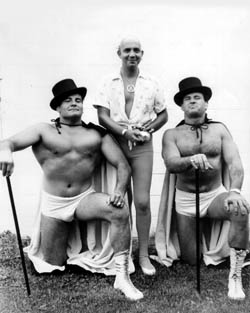
Magnificent Maurice, Mr. Kleen and Johnny Barend. Photo courtesy of the Wrestling Revue Archive
A short while later, he started teaming with Gene Dubuque, who was working as the effeminate Magnificent Maurice. They had known each other a little around New York, and even fought on a few occasions. “We just kind of meshed. We were good friends. I knew he had talent, and he knew I had talent, so we just put it together,” Barend said. Maurice is easily Barend’s best known partner, though he would win tag team titles with another eight accomplices.
“Their appearance in the ring attired in top hats, black capes and colorful trunks have been something new for Hoosier fans,” described an Indiana paper in March 1962, where the duo was managed by Mr. Kleen, a.k.a. Ernie Roth/ Abdullah Farouk/ The Grand Wizard.
In Columbus, Ohio, Barend would grab the microphone and announce to the Central Ohio airwaves, “Women of Columbus, you are pigs! Pigs! Handsome John and Maurice would rather go out with barnyard animals than with you, women of Columbus!”
One of their fans was the entertainer Liberace, who hung around them on one memorable occasion. “Liberace was a great guy,” laughed Barend, who still has a photo of the three of them together. Talk of Liberace and showbiz leads Barend to shake his head about the fate of Maurice.
“Maurice, he always wanted to be in the acting business. The poor guy got killed … He was doing some work out there, somebody didn’t know what to do,” he started, “it was a B-movie of some sort … They loaded them all up on a plane and the plane went into the side of a mountain.” That was January 1974, and it was a mountain in Colorado.
In the early 1960s, Barend rode with Rogers into the about-to-secede from the NWA WWWF/Capitol Wrestling, where he gained further fame. He doesn’t have nice things to say about promoter Vince McMahon Sr., however. In fact, Barend says he was blacklisted — twice — by McMahon, once for working for Argentina Rocca’s short-lived competing promotion, and for speaking up about shady practices.
“McMahon, I was one of the few guys that ever got out — what he used to do to these guys was just terrible. ‘You’re becoming too much of a celebrity, so we’ll hold your money in escrow,'” Barend said. “He would take a big chunk of what you had coming. That wasn’t too much in them days. But none of these guys ever got their money back. There wasn’t no escrow. The escrow was his bank account!”
By the mid-’60s, Barend was firmly established in Hawaii, working for promoter Ed Francis.
On his website, Dutch Savage wrote that Barend was “one heck of a worker and had one of the better gimmicks Hawaii has ever seen. He drew tons of money for Francis.”
Sporting knee-high wrestling boots, dark glasses, top hat and cigar, Barend used the theme to TV’s Batman and later Those Magnificent Men in Their Flying Machines to further his character of being an off-kilter looney telling wacky stories. “I think Johnny’s bubble shifted to one side somewhere along the way and never came back straight,” Curtis Iaukea told the The Honolulu Advertiser in 2005.
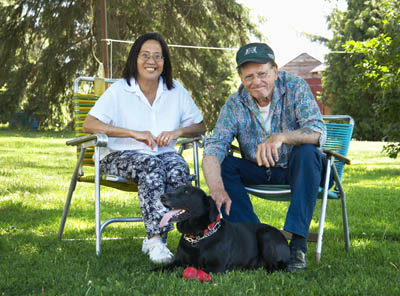
Annie and Johnny, with Joy, in May 2008. Photo by Andrea Kellaway, www.andreakellaway.com
Despite all the success Barend had in Hawaii, his greatest memory will always be meeting and marrying his wife, Annie Lum, in the ring at Honolulu International Center.
She was just a high school senior, walking the beach in Waikiki, when Barend spotted the beauty with the transistor radio. The 1967 wedding was quite the event, the semi-final “bout” of the evening’s card. Fellow wrestler Jim Hady was Barend’s best man, and later in the evening, Barend and Hady teamed up for a bout, with Annie sitting ringside.
“My father was more nervous than us!” laughed Annie, who knew most of the wrestlers pretty well by the time they married. A dais was set up in the ring for the preacher, and rice was thrown on the newlyweds. The cake was a surprise, however, delivered from Leonard’s Bakery and a real challenge to get into the ring with its many tiers. Though the couple never booked a photographer themselves, one came through and presented them with an album of the wedding. “I don’t even know who it was, it was just somebody that decided to do it, they put it all up in this little album for us and just gave it to us. We never asked anybody to do it,” explained Annie.
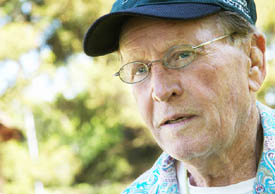
Johnny Barend. Photo by Andrea Kellaway, www.andreakellaway.com
After Barend called it quits on his wrestling career, he and Annie moved close to his hometown of Rochester, and took over a small collection of rental cottages. Though the cottages have been shuttered since 1995, the childless couple still lives on the land. Annie takes karate in a nearby town, and Barend enjoys the time with his dog, and does odd jobs occasionally with friends.
He is quite proud of what he accomplished in his wrestling career, and the notoriety he achieved. Within minutes of each other, he can tell a story about blowing off an appearance at the NFL’s Pro Bowl in Hawaii because he wasn’t going to be paid, and felt that a star of his pedigree should be paid, and then launch into a similar story from 1996, where he appeared at WCW’s Ilio DiPaolo Memorial show in Buffalo, NY.
“They asked me to come down there. I come down there, and the first thing I see is all these football players with limousines being chauffeured to the arena, right? So I drove up with my car with Annie, and they said, ‘Hey, you’ve got to go in the parking lot, and pay $10 to park your car.’ I said, ‘Open up the gates, I’m coming through.’ He said, ‘What do you mean you’re coming through?’ I said, ‘I’m going to park right next to your TV truck there. I’m a celebrity, don’t you know that? I’m going to count to 10, and the end of 10, if you don’t open the gates, I’m not coming in the building. Do you understand that?’ He finally opened the gate.” Barend says he never got paid that night, though other legends did. “I was happy to see the guys. I got up in the ring like a gentleman, took my bow. But then I learn later that a bunch of these guys cut up so much money, the select group.”
The WCW experience is a warm-up to his opinions on the business today, and his lament about staying in it so long.
“Today’s wrestling, you have to remember, consists of drugs, steroids, uppers, downers, pain medication, and everything else you can think of, growth hormones,” he said. “If these guys had to do what we did, and perform in the kind of rings we did — when I think about some of the stuff I’ve done, it scares me today. We performed in rings that were harder than that cement out there, there was no padding, boards without canvas on. I had calluses on my knees that when I stopped, it took 10 or 15 years to get the calluses off me. These guys all have knee pads, or long pants, or everything else. Just think, we went in the ring and performed, and entertained people for an hour without any props, without anybody else scripting the whole match. We didn’t need writers, or teleprompters for interviews.”
Though at times Barend sounds bitter, it’s not quite the right word for it. He is a proud man who survived a shady business. He made some good friends along the way, and lost a few. Unlike many of his old colleagues, his body has held out okay. “I still work out once in a while. I’m basically in excellent shape,” he said. “I came through okay. I’ve got my health and everything else.”
Greg Oliver and photographer Andrea Kellaway learned a lot about peacocks during their visit with the Barends.
RELATED LINKS
- Sep. 21, 2011: Mat Matters: Goodbye to ‘Handsome’ Johnny Barend
- Aug 13, 2012: Original WWWF title found in attic
